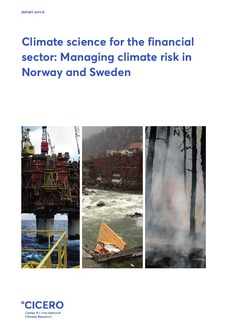| dc.description.abstract | The financial sector must prepare for a higher risk level associated with climate change impacts affecting real estate and infrastructure, as well as climate policies that will impact risk and returns from investments in various sectors.
Representatives from twenty financial institutions in Norway and Sweden have been interviewed on perceptions and management of climate change risks. The purpose was to map knowledge and perceptions, examine current management of climate-related risks and explore how risk management can be improved within these institutions.
Frequently only qualitative assessments of climate risk are made in the financial sector, because data are missing, or there is high uncertainty attached to the figures. Carbon footprint and energy use or intensity are the most common climate risk indicators, but these are insufficient measures to fully assess climate risk. Few institutions have made substantial changes in the organization of their business. Climate risk is often seen in a broader sustainability context, confer the focus on Environmental, Social, and Governance (ESG) performance. The strategy and direction of a company towards more climate-friendliness and robustness is essential to evaluate its credibility and preparedness regarding climate risk. Climate risk also implies new business opportunities.
Currently most of the focus in the financial sector is on companies' disclosure of climate relevant information, since several uncertainties exist and there is no single answer to how climate risk should best be handled. More attention is given to developing a common language on what ‘green’ and ‘climate-friendly’ imply, but even more is needed.
The financial sector needs transparent and useable knowledge on climate change and related risks, both on the broad climate picture as well as the specific issues dependent on their business area. ‘Stress-testing’ an institution regarding risk from the transition to a low-emission society and the physical effects of climate change is a useful framing, where a set of possible futures can be used to assess an institution’s robustness. More learning and capacity building on climate risk are necessary, both in terms of organization and personnel of an institution | en |

